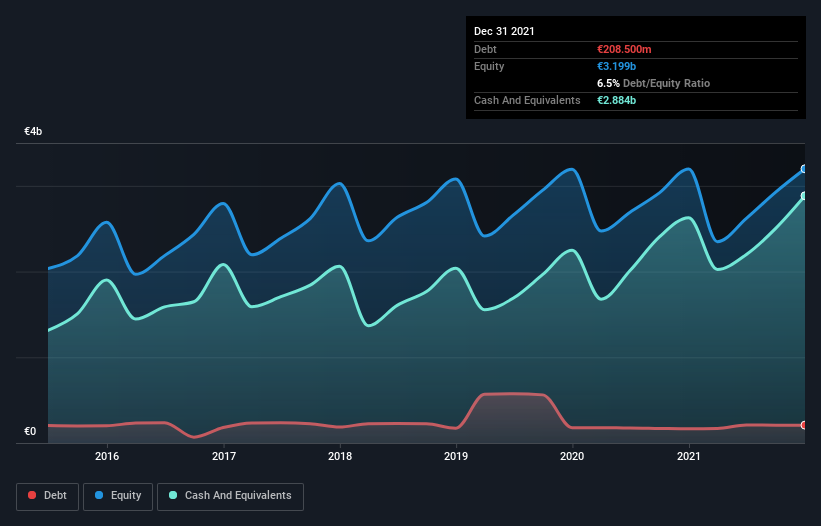
David Iben put it well when he said, 'Volatility is not a risk we care about. What we care about is avoiding the permanent loss of capital.' So it might be obvious that you need to consider debt, when you think about how risky any given stock is, because too much debt can sink a company. Importantly, KONE Oyj (HEL:KNEBV) does carry debt. But should shareholders be worried about its use of debt?
Why Does Debt Bring Risk?
Debt assists a business until the business has trouble paying it off, either with new capital or with free cash flow. Part and parcel of capitalism is the process of 'creative destruction' where failed businesses are mercilessly liquidated by their bankers. However, a more usual (but still expensive) situation is where a company must dilute shareholders at a cheap share price simply to get debt under control. Of course, plenty of companies use debt to fund growth, without any negative consequences. When we think about a company's use of debt, we first look at cash and debt together.
See our latest analysis for KONE Oyj
What Is KONE Oyj's Debt?
You can click the graphic below for the historical numbers, but it shows that as of December 2021 KONE Oyj had €208.5m of debt, an increase on €165.6m, over one year. However, its balance sheet shows it holds €2.88b in cash, so it actually has €2.68b net cash.

How Strong Is KONE Oyj's Balance Sheet?
According to the last reported balance sheet, KONE Oyj had liabilities of €5.70b due within 12 months, and liabilities of €818.0m due beyond 12 months. Offsetting these obligations, it had cash of €2.88b as well as receivables valued at €2.92b due within 12 months. So its liabilities outweigh the sum of its cash and (near-term) receivables by €717.8m.
Since publicly traded KONE Oyj shares are worth a very impressive total of €24.0b, it seems unlikely that this level of liabilities would be a major threat. Having said that, it's clear that we should continue to monitor its balance sheet, lest it change for the worse. While it does have liabilities worth noting, KONE Oyj also has more cash than debt, so we're pretty confident it can manage its debt safely.
Fortunately, KONE Oyj grew its EBIT by 4.7% in the last year, making that debt load look even more manageable. There's no doubt that we learn most about debt from the balance sheet. But ultimately the future profitability of the business will decide if KONE Oyj can strengthen its balance sheet over time. So if you're focused on the future you can check out this free report showing analyst profit forecasts.
Finally, a company can only pay off debt with cold hard cash, not accounting profits. While KONE Oyj has net cash on its balance sheet, it's still worth taking a look at its ability to convert earnings before interest and tax (EBIT) to free cash flow, to help us understand how quickly it is building (or eroding) that cash balance. Happily for any shareholders, KONE Oyj actually produced more free cash flow than EBIT over the last three years. That sort of strong cash generation warms our hearts like a puppy in a bumblebee suit.
Summing up
We could understand if investors are concerned about KONE Oyj's liabilities, but we can be reassured by the fact it has has net cash of €2.68b. And it impressed us with free cash flow of €1.5b, being 109% of its EBIT. So we don't think KONE Oyj's use of debt is risky. There's no doubt that we learn most about debt from the balance sheet. But ultimately, every company can contain risks that exist outside of the balance sheet. For instance, we've identified 2 warning signs for KONE Oyj that you should be aware of.
When all is said and done, sometimes its easier to focus on companies that don't even need debt. Readers can access a list of growth stocks with zero net debt 100% free, right now.
Valuation is complex, but we're here to simplify it.
Discover if KONE Oyj might be undervalued or overvalued with our detailed analysis, featuring fair value estimates, potential risks, dividends, insider trades, and its financial condition.
Access Free AnalysisHave feedback on this article? Concerned about the content? Get in touch with us directly. Alternatively, email editorial-team (at) simplywallst.com.
This article by Simply Wall St is general in nature. We provide commentary based on historical data and analyst forecasts only using an unbiased methodology and our articles are not intended to be financial advice. It does not constitute a recommendation to buy or sell any stock, and does not take account of your objectives, or your financial situation. We aim to bring you long-term focused analysis driven by fundamental data. Note that our analysis may not factor in the latest price-sensitive company announcements or qualitative material. Simply Wall St has no position in any stocks mentioned.
About HLSE:KNEBV
Flawless balance sheet with proven track record.


